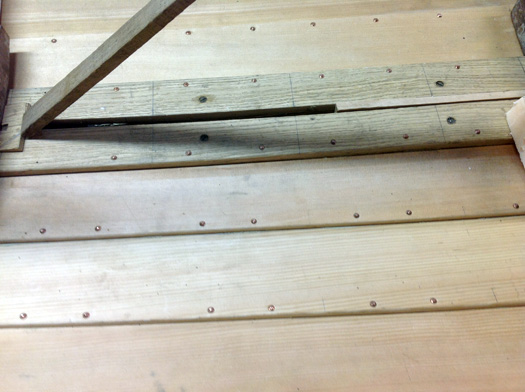Displaying items by tag: XOD
Cowes Fire Destroys Classic Keelboat Fleet
A fire at a boatyard in Cowes on the Isle of Wight yesterday has seen the destruction of around 30 yachts and one-design dayboats, including many irreplaceable classics.
Vintage boats, including a World War Two rescue vessel, are among those feared to have been destroyed in a fire on an Isle of Wight industrial estate.
Thick black smoke billowed over Cowes when the major blaze broke out at Medina Village on Monday.
Classic vessels, including the Dunkirk "little ship" Vere, and racing yachts are believed to be among the wreckage.
Boat building firm owner David Heritage said they were "irreplaceable".
XOD class captain Mike Till reported that seven XOD one-designs were among the boats destroyed in the blaze, which ripped through an industrial unit off Bridge Road known as Samuel White's, formerly Souter's yard. Till described it as 'an unmitigated disaster'.
"It's probably the greatest single loss of boats ever recorded in one place. They were all top-class XODs, old obviously, but in beautiful condition. Three of those boats are the core of the Cowes Division, so it's a huge loss. The Vice-Captain lost his boat, and I am now Class Captain of the whole fleet without an XOD.
"You can't buy a replacement. You could buy another XOD, it's never going to be the boat you've lost. You can't just walk out and buy something off the shelf. My boat was built in 1938, called 'Delight' X75, many of the others were post-war. The point about these boats, we're just guardians of them. There's a heritage here and in the XOD fleet there's a finite number of boats, there are no new ones being built at the moment. They've been around since 1911 and they've never had a loss like this in the XOD fleet before."
Fifteen Etchells keelboats were also destroyed. More from the Yachts and Yachting website here.
The Solent's XOD fleet were featured in WM Nixon's blog here
#historicboats – The historic Water Wag class in Dun Laoghaire have been doing well for some time now, but for 2014 they're already showing even more vitality. W M Nixon reckons they're right up there with the famous X One Designs in the Solent.
Ireland is a small and not very affluent piece of land, surrounded by a lot of water. The Solent is a small piece of water, surrounded by a lot of very affluent land. If you're looking for somewhere very different for your holiday weekend's sailing, it's right there, down south between Hampshire and the Isle of Wight
With the first proper summer Bank Holiday upon us today after a long recession-mired winter, you could be forgiven for thinking about where best to go for a change of scene and mood. Possibly, you're seeking somewhere which is as different as possible from the wide open waters of Ireland, yet provides the kind of sailing to which we can relate.
The Solent is home to very special local class which, when you sail in it, proves to have all the flavour of a good Irish local class, but with the extra ingredient of being a focus of attention in a prosperous area which happens to be one of the global centres of the international marine industry.
The 21ft X One Design is the very essence of Solent sailing, a distinctive presence along that unique waterway, whose name is a matter of conjecture. For me, the word "Solent" has always simply suggested the opposite of "Insolent", as it has the reputation of providing gentle unsurly waters and a choice of snug harbours when things might be rougher outside in the English Channel.
Maybe so, but I can well remember being on passage down Channel from Kent towards Ireland a long time ago with a new trimaran which was proving a tricky proposition. We dodged north of the Isle of Wight for the fun of it, and soon discovered some inherent structural faults in the boat which became startlingly evident in the drubbing provided by strong ebb against the wind in the Western Solent.

The first X One Designs in 1911 were built as a trainer class for the Royal Motor Yacht Club, and carried a very conservative rig. Photo courtesy XOD Assoc.
Be that as it may, the Solent provides a wonderful variety of sailing in its relatively small area, and it suits the X One Design so well that you'll find its local fleets have spread west and east, the most westerly being at Parkstone on Poole Harbour, while the most easterly is Itchenor on Chichester Harbour. In a spirit of fierce local pride the sailors in Poole and at Itchenor will assure you they aren't in the Solent at all, but they've ready access to it, and the great festival of the class is Cowes Week, where the six local fleets assemble annually, mustering an extraordinary 145 boat for the X One Design Centenary in 2011.
Their history may be long, but they're not burdened by it, for the world has older keelboat classes which feel more obliged to adhere strictly to their own original rules, designs and specification. By contrast, the origins of the XOD are very low key. Back in the height of the Edwardian era, the Royal Motor Yacht Club, with a headquarters ship in Southampton Water, reckoned that it would be a good idea if its younger members had the opportunity to learn to sail. As well, with their senior members swanning about in large power yachts seen as elitist, it was probably reckoned it would do the image of the club no harm to have a fleet of boats which could provide sailing for local school children and students. So they commissioned a flotilla of 21ft keelboats from Alfred Westmacott, a noted designer of small keelboats, then had them rigged as simply as possible as gaff sloops with a club boom on the jib. On June 3rd 1911, their first race was sailed.
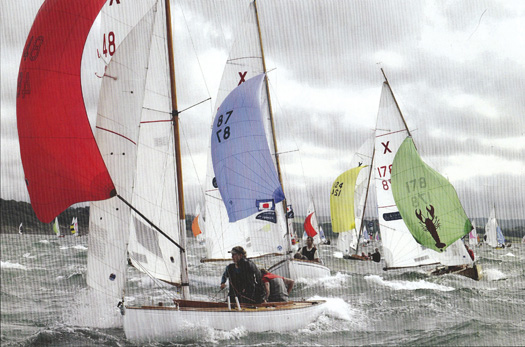
X One Designs doing what they do best, churning up the West Solent at Cowes Week over a weather-going ebb tide. Photo: Rick Tomlinson
As with everything in those days, the Great War of 1914-18 brought sailing to a halt. But by the 1920s, other clubs in the Solent area were cottoning on to the XOD's good all round qualities, which became more widely known when the Royal Motor YC moved itself to new premises at Parkstone on Poole Harbour. The growing class acquired its first Bermudan rig in 1928, with a notably large mainsail. This was mercifully reduced by shortening the boom in 1951, thus enabling a standing backstay to be carried, and today the rig is well able to provide crisp performance.
By the 1950s the class was taking off, regularly bringing the largest fleet to Cowes Week. But local racing was very strong too. Lymington had provided fertile ground for expansion, and the town's half day being a Wednesday (hands up anyone who remembers when shops used to close for one entire afternoon at lunchtime mid-week), that's when the XODs had their keenest racing. Back in the day, if you happened to be doing business with a yacht design or marine engineering office in Lymington, it was a waste of time trying to contact anyone there on a Wednesday afternoon - they were all out racing their XODs.
Though the hull has remained strictly as designed by Westmacott, and though traditional wood construction of carvel planking on bent frames still prevails despite attempts to introduce edge-glued strip planking or even GRP, with so many world class talents getting involved in XOD racing, the layout of the cockpit, and the tuning of the very simple-looking rig, have been refined to a very high level.
The result is excellent ergonomics in the cockpit layout. Unlike some keelboats in which only the helmsman has an athwartships seat, the XOD has decently comfortable fore-and-aft benches either side, and at 21ft she's just big enough to accommodate them without the side decks being made dangerously narrow. The mainsheet and several other controls are led to a pillar at mid-cockpit, while further control on the main is provided by the full length track across the after deck with the carriage adjusted by a single line which goes from the carriage through a mini hawsehole in the deck at centre-line, and forward underneath everything to come up to a jammer on the aft side of the pillar.
As for the mainsheet itself, this is continuous, going through a double jammer very easily accessed on top of the pillar. The result to a tyro XOD sailor like me seems to be that if you haul on something – anything - which is clearly the sheet, the main comes in, and if you let it out, out she goes with never a bother.
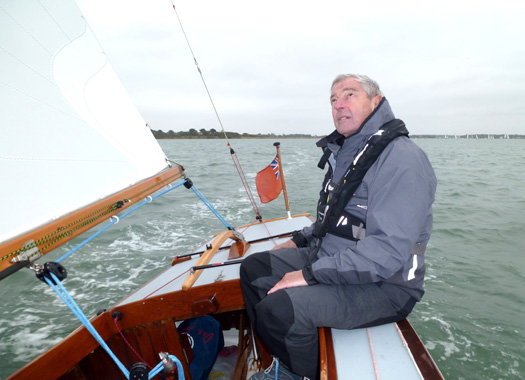
Ted Roose at the helm of his beloved 1953-built XOD Thora, heading down to the start with the ensign flying to indicate the boat is not yet racing. Photo: W M Nixon

This is the bit that really does the business. The vital pillar carries the easily-handled mainsheet and other controls. The line on the forward side is the hauler for raking the mast forward. Photo: W M Nixon
But then, maybe I was lucky with my skipper, Ted Roose of Itchenor Sailing Club, who provided me with my maiden XOD race last September aboard his XOD Thora, no 101 built 1953, as it was great sport throughout. But Ted being one of those quietly determined skippers who is usually in the frame, his competence in handling his boat in some lovely close quarters competition probably made it all seem much easier than it really was. And as the race progressed on an unseasonal grey Saturday afternoon, but with a decent little breeze, I was lost in admiration for a deceptively simple yet very effective cockpit layout which added greatly to the pleasure of sailing.
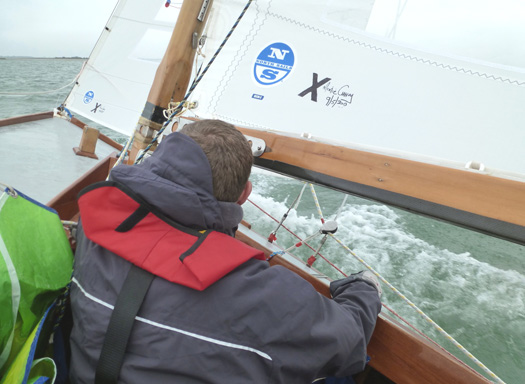
There's no need to clamber out of the X One Design's cockpit when setting the spinnaker, as the forward crewman is sitting on the "mezzanine thwart" which gives him enough height when standing to do the job quickly and easily. Photo: W M Nixon
For instance, at the forward end of the cockpit, some genius many years ago introduced a "mezzanine thwart". This means that the forward or third hand, the spinnaker person, has somewhere useful to sit where they are much more comfortable than merely crouching. They also have a useful line of sight under the jib, they keep down low out of the helmsman's line of vision, and then when they come to set the spinnaker, lo and behold they have the height to do it easily by standing on the thwart, which has a non-slip surface, with no need to go on the foredeck at all.
And when you've the spinnaker up on a dead run, the skipper quietly requests the mid boat man to give a mighty heave on a line which runs up the forward side of the pillar. The foot of the mast then comes aft on a slider for what looks like all of five inches, and downwind performance is improved by having the rig then hanging – actually drooping, some might say - over the bow.

When the X One Designs put rake in their mast, they don't mess about......running position left, beating position right. Photo: W M Nixon
The race offered an ideal opportunity to see the Itchenor class in action, as Ted had very obligingly agreed to go out for just the middle race of a three race weekend series which was nicely designed in civilized style with two races on the Saturday, then one on Sunday morning with a very relaxed lunchtime prize-giving in the clubhouse afterwards.
Fortunately the one race we did had far and away the best breeze of the weekend. Thus we didn't feel too bad about depriving Ted of his full quota of sport, but one race was the limit, as the foredeck hand and his father the visiting crewman were obliged to be present at the Christening of one Magnus at the Parish Church in Bosham next morning. That was something which in turn seemed part of a bigger picture, as the church in Bosham was frequented by King Canute, one of the more civilized Vikings rulers of England, while young Magnus takes his name from St Magnus the Martyr, who persuaded his fellow Vikings to ease off on the violence, but thereby lost his head in becoming the first and last Viking saint.

Chasing up the opposition – the easily controlled X One Design gives splendid close quarters racing. Photo: W M Nixon

Once the crew in the other boat start looking astern all the time, you know you're closing in for the kill. Photo: W M Nixon
Such things were far from our mind as we sailed a busy little race, made even busier by the assumption that in this three class series, the XODs would as usual be starting five minutes after the Sunbeams which in turn would be five minutes after the Swallows. But some cunning devil had decided that the start order should be Swallows, then XODs, and then the Sunbeams. It definitely wasn't Thora's best-ever start, but with a mountain to climb, Ted was in his element. He was brilliant. With fifteen boats racing, and just about all of them ahead at the start, we nevertheless got up to fourth at one stage, and though we were either sixth or seventh at the finish, it had been a marvellous afternoon's close quarter sport in which we'd experienced local racing at its very best.
The keen local level of Itchenor racing transferred to Cowes Week very well in 2013. And our header photo shows why the XODs revel in racing at Cowes. They're just the right size to make the Solent interesting and sometimes quite a challenge. And it's a special pleasure to use that particular photo, as it was taken by James Tomlinson aged 14, son of ace maritime snapper Rick Tomlinson. The apple seldom falls far from the tree.

John Tremlett, overall winner of the X One Design Class at Cowes Week 2013. Photo: W M Nixon
Leading the charge for Itchenor at Cowes was John Tremlett sailing Jeremy Lear's 1946-built Lass, who won overall in a fleet of 79 boats. For the Centenary in 2011 they had tried some Committee Boat starts to accommodate the 145 boat fleet, but the essence of racing XODs at Cowes continues to be the fixed start on the line from the Squadron Castle. We were yarning after the racing in Itchenor, and I asked the prime question: How on earth anyone come winning out of a start situation like that?
Simple really, said big John. You know there is one perfect spot right in under the castle from which to make your start. The secret is to get as near to that spot as possible while still keeping your wind clear and keeping the boat with good way on. You absolutely must keep a clear wind. So easy, don't y'know.....?

The classic X One Design start on the Squadron line at Cowes. No 123, Lara built by Burnes of Bosham in 1960, has either got it spot on, or they're in for a 7% penalty.
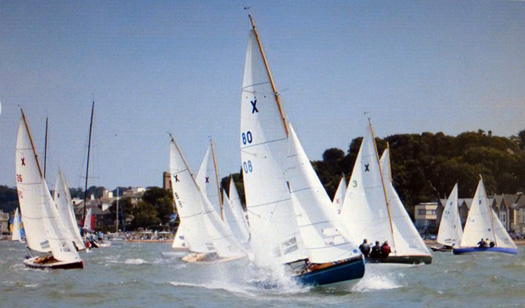
The 1946-built Lass (no 80), helmed for Jeremy Lear by John Tremlett, has emerged from a start in Cowes Week 2013 in a very strong position, with the fleet nicely under control.
Inevitably, when you've savoured something as good as XOD racing with on of the hotter fleets, you try to find comparisons in Irish sailing. Back in the 1950s it was surely the Dublin Bay Mermaids, which had fleets along the East Coast all the way from Wexford to Skerries, and had the turnouts nudging the 90 mark for their annual Mermaid Week.
But this year is the first in which Mermaids don't figure in the Dublin Bay programme. They just became too thinly spread, whereas the XODs are quite the opposite. They are the Number One local class on what is in effect a salt water lake, with their boats built both on the island and on the Hampshire shore, and they're within ready reach of an extensive and very affluent part of England.
So where in Ireland do we have a salt water lake in the midst of a large and affluent population? Dun Laoghaire, that's where. In its way, the harbour at Dun Laoghaire, rather than Dublin Bay itself, is the Solent of South Dublin. And if we accept that this is the case, then obviously the equivalent of the XODs in Dun Laoghaire Harbour will have to be a smaller boat, and a local class with a bit of history to it as well.
Step forward the Water Wags. They're currently on a roll with turnouts which are modern records for the class. A new boat – number 45 – is being built by Jimmy Furey of Lough Ree for and with Cathy MacAleavey. And among the boats already in existence, there's a strong sense of community allied to a lively spirit of competition.
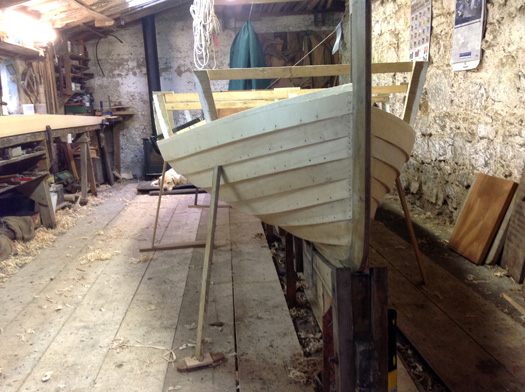
The beauty of traditional clinker construction. Water Wag no 45 is currently being built by Jimmy Furey near the shores of Lough Ree. Photo: Cathy MacAleavey
There's history too, of course, and it's even more interesting than the XODs. Or indeed any other One Design class, for the Water wags were the first One Design Class of all in 1887, using a pretty little double-ended 12ft dinghy series-built in Scotland.

The "new" Water Wags in action in Dun Laoghaire Harbour for the regular Wednesday evening race . The current design was introduced in 1902-03 to replace the original smaller Water Wag from 1887. Photo: Cathy MacAleavey
But then, as other newer and bigger classes began to poach their sailors during the hyper-growth of Dublin Bay Sailing Club around 1900, the Water Wags took a radical step which some other classes could usefully emulate. They got James Doyle the local boat builder to design them a much more able 14ft gunter sloop-rigged dinghy, and changed en masse in 1902-03, changing their game in a way some other classes might like to do, but have never managed.

The Doyle design team, father and daughter or maybe just daughter alone, successfully fulfilled the brief for a new larger Water Wag very well, and today they race more enthusiastically than ever in their "salt water lake" of Dun Laoghaire Harbour. Photo: Cathy MacAleavey
The creation of the new boat brought its own stories. James Doyle's daughter Maimie was at the very least a talented draughtswoman who put manners on her father's rough sketches to turn them into finished designs. But some would argue that she actually designed the new Water Wags. Certainly some time later the Doyle-created designs of a projected cruising yacht called Granuaille appeared in one of the sailing magazines, and the write-up clearly hinted that it was entirely Maimie's own work. This got her poor father so much stick that a subsequent issue of the magazine was obliged to list all the boat designs he – and he alone – had created.
Maimie Doyle's boat design achievements between 1890 and the outbreak of war in 1914 become all the more remarkable when we consider that there have been very few women naval architects in the hundred years since. But who knows, now that Cathy MacAleavey is again working along with Jimmy Furey on a boat-building project (they've already created a lovely Shannon One Design), perhaps she might turn her hand to the design side too.
Meanwhile the Maimie Doyle-designed Water Wags have become a sociological phenomenon in Dun Laoghaire. In times long past, they would appear at regattas elsewhere, but these days they seldom go out of the harbour, as it provides an ideal sailing stadium, though they're so manageable that every so often there's a trailer-borne class excursion to one of Ireland's great lakes.
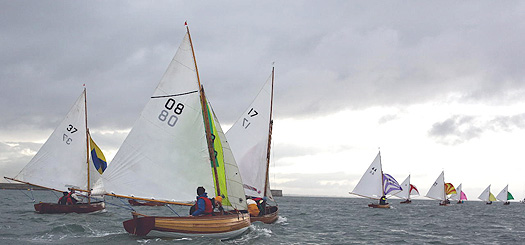
The clouds are lifting. Today's Water Wags hasten towards a bright horizon. Photo: Cathy MacAleavey
Jimmy Furey's boat-building is a work of art. Detail at the centre-plate slot of the new No 45, where the steamed frames will be bent to fit neatly in the larger gaps between the fastenings. Photo: Cathy MacAleavey
Manageability and community. That really is the essence of the Water Wags' new wave of vitality. Nevertheless, there'll always be people in Ireland who will only feel comfortable with a keel under them, people who seek an ergonomically-sound little keelboat with a surprisingly good performance. And one of minimal maintenance too. The Water Wags may be able to find handy sheds for their hibernation and off-season maintenance, but our climate is cruel for little wooden keelboats, so we need a good little glassfibre semi-traditional keelboat bigger than a Squib or a Flying Fifteen.
But why reinvent the wheel? It's just possible that somewhere around Lymington there's one of the glassfibre XODs which were reputedly built as an experimental project, but like the glassfibre Mermaids, were rejected by traditionalists. A glassfibre XOD might just suit Irish conditions very well indeed.

Action at the weather mark. With their intensive racing within Dun Laoghhaire Harbour, the reinvigorated Water Wags are a sociological and sporting phenomenon, and their regular Wednesday evening race is a highlight of the harbour's weekly progamme. Photo: Cathy MacAleavey




























